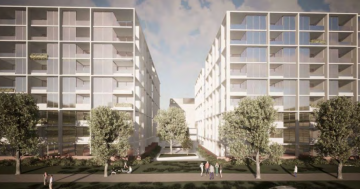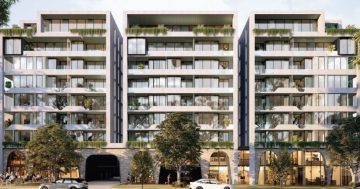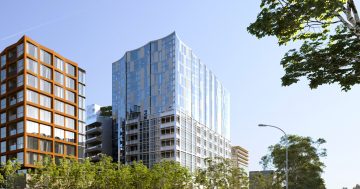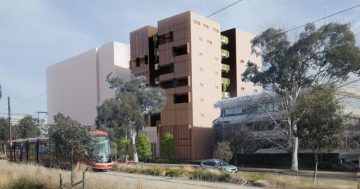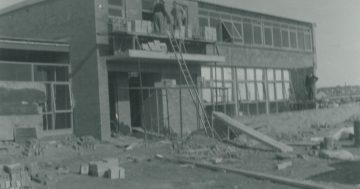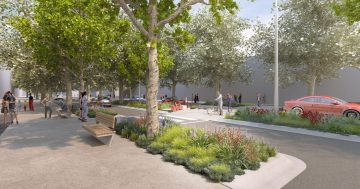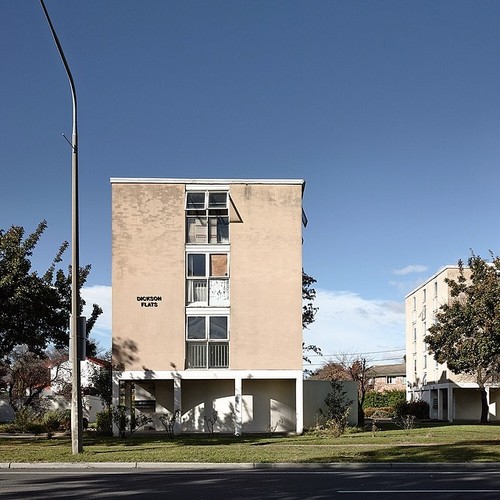
Canberra is undergoing a metamorphosis. Until now, it has grown outwards, slowly engulfing farms and spitting them back out as suburbs, terraforming the landscape from grazing pastures to a white collar playground. Shopping centres, cars, cafes, the tame opiates of the archetypal Canberran.
The age and maturity of this town is becoming more obvious, however. As the houses of Gungahlin roll off the assembly line, they spill East towards the New South Wales border, the high-water mark. But the Capital Territory is now emerging from its prepubescent sprawl to push skyward into the third dimension. Like shiny white iPhones, apartment buildings have begun accumulating along the city skyline, full of the promise of progress and a conveniently compact lifestyle. These lofty shoeboxes practically have a use-by date branded alongside the facade, accompanied by the small cracks which will inevitably begin to show in their cheap concrete casings.
Walter Burley Griffin’s legacy ensured that the planning wonks of this town developed a severe allergy to buildings greater than two (okay, five) storeys. The first consequence of this approach to ‘civic design’ is that residents of Canberra are more or less immobile without access to a car. At the time of conception, Canberra and cars were a match; a city of the future using the horse and cart of the future. Today, as Canberrans we have great roads and are practically forced to use them to get anywhere particularly useful or interesting.
The aversion to urban density raises ramifications that are beyond mere convenience and efficient transport. A great deal of the city’s observable history is at stake. Canberra is relatively young, but one hundred years is still sufficient time to accumulate an identity. This urban identity is crafted through buildings and architecture, unobservable from the city blueprint. Certainly, we have some masterful architecture in this city, but mostly on the Federal side of things, things that were meant to be grand. I’m referring to the everyday, the entire aggregate. Alley ways, nooks and crannies. The combined sense of adventure, nostalgia and the numberless impressions left by the ghosts of the past.
Many of the buildings that hold this cultural and intrinsic value are positioned in high-value inner city areas which were developed over fifty years ago. These buildings are small houses with the odd duplex flecked in the mix. In a city which can no longer grow out, but up, the value of this land is being bid over and hiked up by hungry developers ready to cramp more people into less space. Which prevails, economics or history?
If you have strolled through commercial (once industrial) and residential Braddon, the prevailing force is obvious. Red brick duplexes and warehouses have given way to glass and concrete units, the streets dotted with For Sale signs. Having lived in Braddon for a short time abstract memory remains the only connection to a particular period in my life, as that house and the entire street I lived on was flattened, rebuilt and estranged in two short years. Like a contrived hipster, property developers have pumped out elegant urbane living, but the ironic result is industrial scale conformity. My old haunt is now shockingly homogenous.
It is not just the brick and mortar relics of Canberra’s past that are in jeopardy. The burgeoning creative culture, its genesis found in the repurposing of old industrial spaces, is being rapidly undone. Local vendors are faced with hopscotching from location to location as their previous digs are swallowed by apartments and soulless commercial retail space. Inevitably these industrial spaces that are characteristic of such creative shifts will run out. And then what will be left?
Braddon was the first to go. Now the redevelopment creep marches onward to the doormat of this city, Northbourne Avenue. Previously I would have expressed my distaste for many buildings along Northbourne, notably the Dickson ‘junkie’ flats. As one enters Canberra, these boxy, brown blocks appear Orwellian and ominous. I would have described them as ugly. But taste is relative. Bombarded by the slick and new, the old is now rare and precious.
The death of Dickson Towers is in the pipeline. This is where the debate is crystallised and all the shades of grey revealed. The sale and redevelopment of this land would replace the 157 flats with a precinct of 1099 apartments, valued at a total of $70 million. The “economic benefits” of this construction are estimated to be $380 million. Thankfully, the government can’t just do whatever they please. A roadblock in the application has emerged via the ACT Heritage Council.
The buildings are historically significant at a local and national level. In the late fifties the Capital gained increased administrative importance for the Commonwealth as many government departments were being relocated from Melbourne. The flats were built as a direct response to the influx of public servants and a time of rapid growth. They commemorate the growing pains of a city and the political restructuring of a nation. Sydney Archer, one of the architects is counted among Australia’s most important during the last century. His design reflects the Post-War era of Bauhaus and cubism styles, and is the only complex of its type in Australia to truly reflect these German origins.
Another metamorphosis is the government’s vision of a light rail network, with the central nerve of the system being Northbourne Avenue. Personal opinions aside, the project is a bold one that has the potential to rejig the car-centric status quo and alter the design of the city forever.
This is where we come full circle. The sale and redevelopment of the Dickson Towers is part of the ACT government’s plan to finance the light rail. The next growing pain of this City will wipe the memory of the old one. The future will be at the cost of our history.
What does this mean? At the end of the day there is no clear answer. Canberra, in many ways, needs change. To remain a viable city for the future, urban density is key. The light rail has the potential to be a visionary and transformative project. But it would be a shame to erase and rebuild the entire physical identity of our city. Much like the farms of old, urban Canberra as we know it will degrade and die with monoculture. Diversity, a mix of the old and new, is the ticket to a vibrant and wonderful city.












